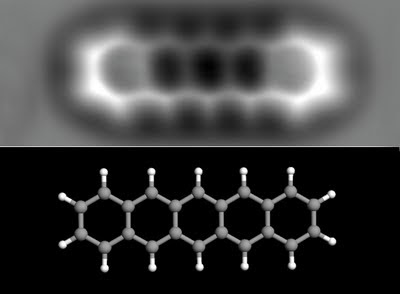 Científicos de IBM han obtenido la imagen de la "anatomía", estructura química, de una molécula con una precisión sin precedentes, empleando una técnica compleja denominada Microscopía de Fuerza Atómica sin contacto.
Científicos de IBM han obtenido la imagen de la "anatomía", estructura química, de una molécula con una precisión sin precedentes, empleando una técnica compleja denominada Microscopía de Fuerza Atómica sin contacto.Los resultados llevan la exploración de moléculas y átomos a la escala más pequeña conocida, y podrían tener gran impacto sobre el campo de la nanotecnología, que busca entender y controlar los objetos más pequeños conocidos por el hombre.
La molécula, es el Pentaceno, una molécula achatada con 22 átomos de carbono y 14 atómos de hidrógeno, y que mide 1,4 nanómetros, aproximadamente 1 millón de veces más pequeña que un grano de arena. En la imagen experimental, se aprecian la forma hexagonal de los cinco anillos de carbono y los átomos de carbono están resueltos con claridad. Incluso se pueden deducir de la imagen, las posiciones de los átomos de hidrógeno.
Los resultados han sido publicados en el número del 28 de agosto de la revista Science
IBM scientists have been able to image the “anatomy” -- or chemical structure -- inside a molecule with unprecedented resolution, using a complex technique known as noncontact atomic force microscopy.
The results push the exploration of using molecules and atoms at the smallest scale and could greatly impact the field of nanotechnology, which seeks to understand and control some of the smallest objects known to mankind.
The chosen molecule is the Pentacene, an oblong organic molecule consisting of 22 carbon atoms and 14 hydrogen atoms measuring 1.4 nanometers in length. The spacing between neighboring carbon atoms is only 0.14 nanometers—roughly 1 million times smaller then the diameter of a grain of sand. In the experimental image, the hexagonal shapes of the five carbon rings as well as the carbon atoms in the molecule are clearly resolved. Even the positions of the hydrogen atoms of the molecule can be deduced from the image.
The result have been published in the 28 August 2009 issue of the Science magazine
Tomado de/Taken from Science Daily
Resumen de la publicación/Abstract of the scientific paper
The Chemical Structure of a Molecule Resolved by Atomic Force Microscopy
Leo Gross, Fabian Mohn,Nikolaj MollPeter Liljeroth and Gerhard Meyer1
Science, 325 (5944)1110-1114(2009)
DOI: 10.1126/science.1176210
Abstract
Resolving individual atoms has always been the ultimate goal of surface microscopy. The scanning tunneling microscope images atomic-scale features on surfaces, but resolving single atoms within an adsorbed molecule remains a great challenge because the tunneling current is primarily sensitive to the local electron density of states close to the Fermi level. We demonstrate imaging of molecules with unprecedented atomic resolution by probing the short-range chemical forces with use of noncontact atomic force microscopy. The key step is functionalizing the microscope’s tip apex with suitable, atomically well-defined terminations, such as CO molecules. Our experimental findings are corroborated by ab initio density functional theory calculations. Comparison with theory shows that Pauli repulsion is the source of the atomic resolution, whereas van der Waals and electrostatic forces only add a diffuse attractive background.
No hay comentarios:
Publicar un comentario